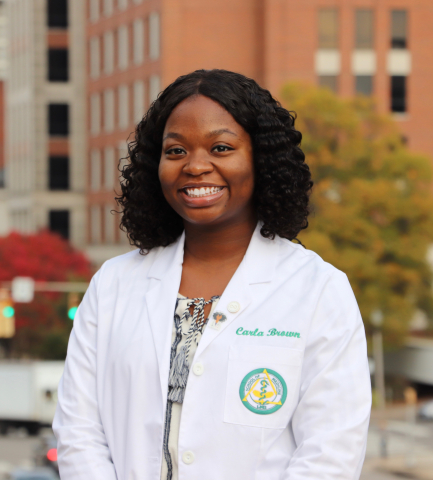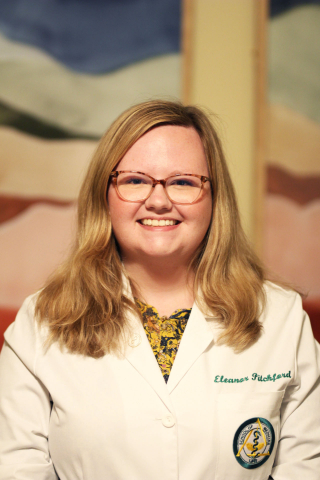When they look toward their future in medicine, UAB Heersink School of Medicine students Carla Brown and Ellie Pitchford both envision practicing medicine in rural communities similar to the ones that shaped them.
Growing up in Batesville, Miss., Brown, who will study at UAB’s Tuscaloosa campus, saw how people in the small, rural town cared for each other, but also how they struggled to access high quality, timely medical care, particularly if they needed to see specialists or were facing an emergency.
“We have one or two family medicine physicians who I have known my whole life, and a small hospital that has threatened to close several times. We do not have a lot of specialties; they just got rid of labor and delivery,” Brown said. “Growing up in that environment, I have seen several people in life-or-death situations need to get to the nearest hospital with specialists who can treat them and unfortunately pass before they can make it there.”
Raised roughly 200 miles away in Scottsboro, Ala., Ellie Pitchford noticed similar trends as friends and family sought medical care.
“My grandparents often had to travel 45 minutes to see their primary care provider,” said Pitchford, who lived in Scottsboro until age 21, when her family moved to Birmingham. “There is also a significant lack of mental health resources in rural communities, something that I would like to address as a provider and make available to my patients.”
Both Brown and Pitchford are MS1 students and members of the latest cohort of the UAB Department of Family and Community Medicine’s Comprehensive Urban Underserved and Rural Experience program, or CU2RE. Launched in 2020, CU2RE is designed to enhance the recruitment, training and retention of medical students dedicated to serving as family medicine physicians in underserved rural and urban areas of Alabama.
The program recently admitted a second cohort of 16 students, Brown and Pitchford among them, after kicking off with an inaugural cohort of eight students in 2020. Students, who can choose between an urban underserved and rural medicine track, remain in the program throughout their four years in medical school. They are paired with a dedicated mentor and complete web-based modules, monthly early clinical exposure experiences and an intensive summer program during their first two years, along with a four-week Family Medicine Clerkship in their third year and a four-week Family Medicine Acting Internship in their fourth year.
“Our goal is to provide CU2RE students with early, hands-on clinical experience and a unique curriculum that will better prepare them to serve patients in these areas of critical need – both in rural and urban underserved communities,” said Jill Marsh, M.D., assistant professor and director of the CU2RE program’s urban underserved and rural pathways. “The students learn to be a personal physician for their panel of patients through mentorship and clinical exposure, but they also learn about how to assess and address the non-medical factors that are crucial to truly transform long-term health outcomes for their patients.”
For example, students learn how to collaborate in interprofessional teams, how to address a patient’s social determinants of health, how to measure the quality of care delivery, how to adjust their care approach based on the unique cultural and linguistic needs of their patients, and how to use nontraditional methods of connecting with patients, such as telehealth.
“We want to ensure that, no matter where they live or what their situation, patients can access excellent care from physicians who are prepared to meet them where they are in life and location,” Marsh said.
Brown said she was especially drawn to the early clinical experience and mentorship that the CU2RE program offers.
“I am excited about getting a lot more hands-on experience early in medical school and about the mentorship aspect of the program,” Brown said. “I did not really have a lot of guidance getting to medical school, so it was very important to me to find that here. I am also excited to be with others who are interested in primary care and family medicine, to bounce ideas off each other and share experiences that might be different from those I have had.”
Pitchford, who will study at the Huntsville campus, said she applied to CU2RE because she is “hungry for clinical opportunities to start serving people now, instead of having to wait.”
“Growing up, I always saw the doctors [in Scottsboro] use medicine as a way to serve people and that is what attracted me to medicine,” she said. “If I am going to spend all of this time in school, I want to come out of it able to serve people and serve some of the most vulnerable populations, including rural people.”
Both women believe that an influx of family medicine and primary care physicians, supported by programs like CU2RE, can help solve some of the problems patients face in rural areas.
“I saw a lot of health disparities in my community, which really made me want to practice in a similar area,” Brown said. There are a lot of different challenges, she said, from gaps in health literacy that keep patients and providers from understanding the patients’ concerns and how to treat them, to logistical challenges like transportation to and from appointments.
“Providers in rural areas have to understand where patients are coming from, what challenges they face,” Brown said.
Pitchford also wants to make one thing clear to her classmates and fellow aspiring physicians: providing care in rural communities is challenging, meaningful and valuable work.
“I think sometimes there is this expectation or bias that medical students who are interested in rural medicine are limiting themselves or taking the easy route,” she said. “I want people to be encouraged. You are not limiting yourself in rural medicine. Medicine is all about serving the patient and you will do that every day.”